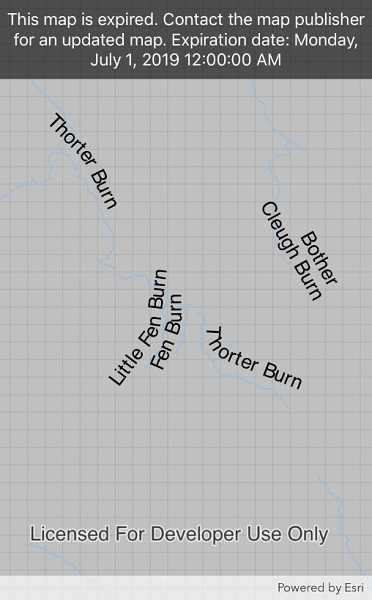Access the expiration information of an expired mobile map package.

Use case
The data contained within a mobile map package (MMPK) may only be relevant for a fixed period of time. Using ArcGIS Pro, the author of an MMPK can set an expiration date to ensure the user is aware the data is out of date.
As long as the author of an MMPK has set an expiration date, the expiration date can be read even if the MMPK has not yet expired. For example, developers could also use this API to warn app users that an MMPK may be expiring soon.
How to use the sample
Load the sample. The author of the MMPK used in this sample chose to set the MMPK's map as still readable, even if it's expired. The sample presents expiration information to the user.
How it works
- Create a
MobileMapPackagepassing in the path to the mobile map package's location on the device. - Load the mobile map package.
- Present
Expirationinformation to the user with:
- Use
Expiration.Messageto get the expiration message set by the author of the MMPK. - Use
Expiration.DateTimeto get the expiration date set by the author of the MMPK.
Relevant API
- Expiration
- MobileMapPackage
Offline Data
The mobile map package is available in ArcGIS Online. The map shows rivers in Scotland with unique annotation.
Tags
expiration, mmpk
Sample Code
// Copyright 2019 Esri.
//
// Licensed under the Apache License, Version 2.0 (the "License"); you may not use this file except in compliance with the License.
// You may obtain a copy of the License at: http://www.apache.org/licenses/LICENSE-2.0
//
// Unless required by applicable law or agreed to in writing, software distributed under the License is distributed on an
// "AS IS" BASIS, WITHOUT WARRANTIES OR CONDITIONS OF ANY KIND, either express or implied. See the License for the specific
// language governing permissions and limitations under the License.
using ArcGISRuntime;
using ArcGISRuntime.Samples.Managers;
using Esri.ArcGISRuntime.Mapping;
using Esri.ArcGISRuntime.UI.Controls;
using Foundation;
using System;
using System.Linq;
using UIKit;
namespace ArcGISRuntimeXamarin.Samples.HonorMobileMapPackageExpiration
{
[Register("HonorMobileMapPackageExpiration")]
[ArcGISRuntime.Samples.Shared.Attributes.Sample(
name: "Honor mobile map package expiration date",
category: "Map",
description: "Access the expiration information of an expired mobile map package.",
instructions: "Load the sample. The author of the MMPK used in this sample chose to set the MMPK's map as still readable, even if it's expired. The sample presents expiration information to the user.",
tags: new[] { "expiration", "mmpk" })]
[ArcGISRuntime.Samples.Shared.Attributes.OfflineData("174150279af74a2ba6f8b87a567f480b")]
public class HonorMobileMapPackageExpiration : UIViewController
{
// Hold references to UI controls.
private MapView _myMapView;
private UILabel _expirationLabel;
public HonorMobileMapPackageExpiration()
{
Title = "Honor mobile map package expiration date";
}
private async void Initialize()
{
try
{
// Path to the mobile map package.
string mobileMapPackagePath = DataManager.GetDataFolder("174150279af74a2ba6f8b87a567f480b", "LothianRiversAnno.mmpk");
// Create a mobile map package.
MobileMapPackage mobileMapPackage = new MobileMapPackage(mobileMapPackagePath);
// Load the mobile map package.
await mobileMapPackage.LoadAsync();
// Check if the map package is expired.
if (mobileMapPackage.Expiration?.IsExpired == true)
{
// Get the expiration of the mobile map package.
Expiration expiration = mobileMapPackage.Expiration;
// Get the expiration message.
string expirationMessage = expiration.Message;
// Get the expiration date.
string expirationDate = expiration.DateTime.ToString("F");
// Set the expiration message.
_expirationLabel.Text = $"{expirationMessage}\nExpiration date: {expirationDate}";
// Check if the map is accessible after expiration.
if (expiration.Type == ExpirationType.AllowExpiredAccess && mobileMapPackage.Maps.Count > 0)
{
// Set the mapview to the map from the mobile map package.
_myMapView.Map = mobileMapPackage.Maps[0];
}
else if (expiration.Type == ExpirationType.PreventExpiredAccess)
{
new UIAlertView("Error", "The author of this mobile map package has disallowed access after the expiration date.", (IUIAlertViewDelegate)null, "OK", null).Show();
}
}
else if (mobileMapPackage.Maps.Any())
{
// Set the mapview to the map from the mobile map package.
_myMapView.Map = mobileMapPackage.Maps[0];
}
else
{
new UIAlertView("Error", "Failed to load the mobile map package.", (IUIAlertViewDelegate)null, "OK", null).Show();
}
}
catch (Exception e)
{
Console.WriteLine(e.Message);
}
}
public override void LoadView()
{
// Create the views.
View = new UIView() { BackgroundColor = ApplicationTheme.BackgroundColor };
_myMapView = new MapView();
_myMapView.TranslatesAutoresizingMaskIntoConstraints = false;
_expirationLabel = new UILabel
{
Text = "Map package not expired.",
AdjustsFontSizeToFitWidth = true,
TextAlignment = UITextAlignment.Center,
BackgroundColor = UIColor.FromWhiteAlpha(0, .6f),
TextColor = UIColor.White,
Lines = 0,
LineBreakMode = UILineBreakMode.WordWrap,
TranslatesAutoresizingMaskIntoConstraints = false
};
// Add the views.
View.AddSubviews(_myMapView, _expirationLabel);
// Lay out the views.
NSLayoutConstraint.ActivateConstraints(new[]{
_myMapView.TopAnchor.ConstraintEqualTo(View.SafeAreaLayoutGuide.TopAnchor),
_myMapView.BottomAnchor.ConstraintEqualTo(View.BottomAnchor),
_myMapView.LeadingAnchor.ConstraintEqualTo(View.LeadingAnchor),
_myMapView.TrailingAnchor.ConstraintEqualTo(View.TrailingAnchor),
_expirationLabel.TopAnchor.ConstraintEqualTo(View.SafeAreaLayoutGuide.TopAnchor),
_expirationLabel.LeadingAnchor.ConstraintEqualTo(View.LeadingAnchor),
_expirationLabel.TrailingAnchor.ConstraintEqualTo(View.TrailingAnchor),
_expirationLabel.HeightAnchor.ConstraintEqualTo(80)
});
}
public override void ViewDidLoad()
{
base.ViewDidLoad();
Initialize();
}
}
}